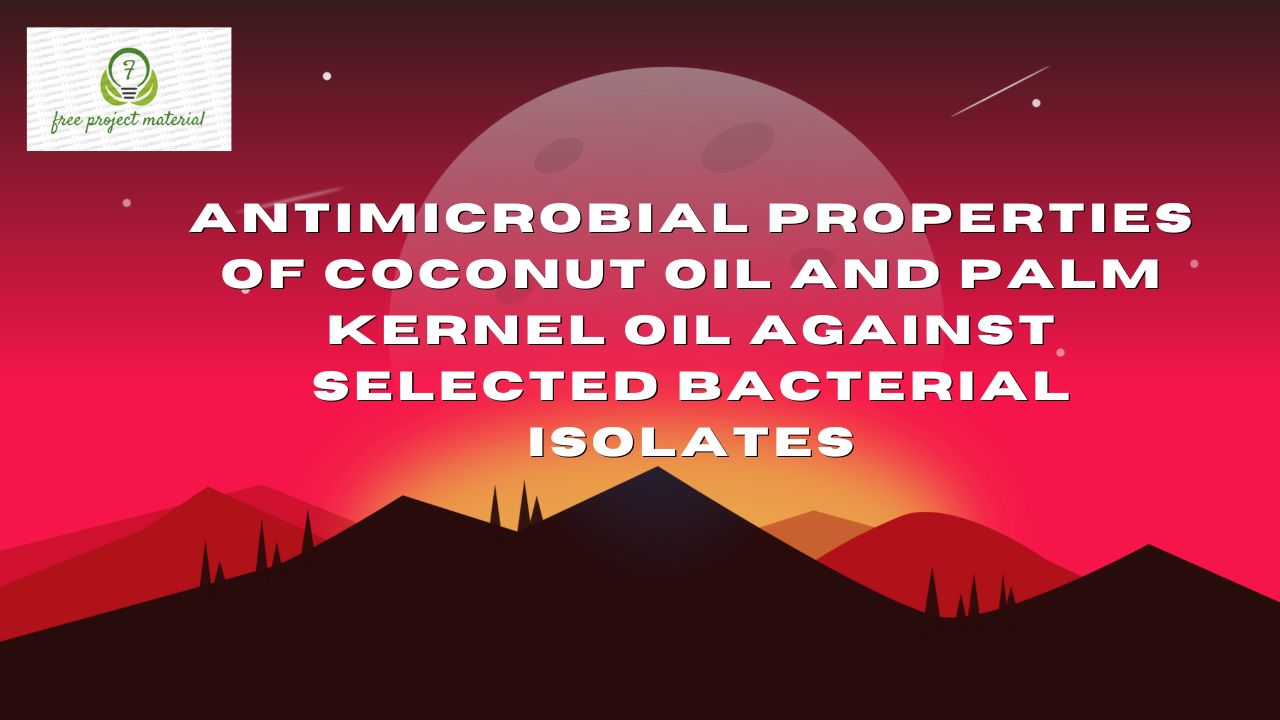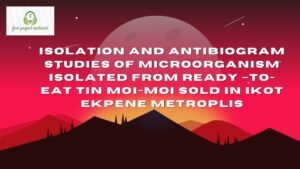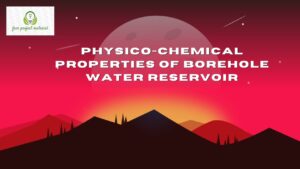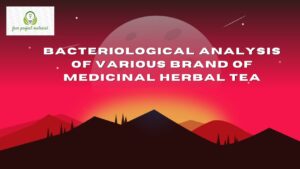ABSTRACT
The antimicrobial properties of coconut oil and palm kernel oil against selected bacteria isolates was carried out using standard microbiological technique. The traditionally, extracted coconut oil and traditionally extracted palm kernel oil have been used in the south eastern Nigeria for the treatment of various diseases and skin infections. Four bacteria namely; Pseudomonas, Streptococcus, Straphylococcus and Escherichia coli known to cause some infections treatable with this oil were investigated. The susceptibility of the organism were carried out on Muller-Hinton agar using disc diffusion method. The coconut oil and palm kernel oil were prepared at 10%, 40%, 70%, 80% and 100% concentration. Coconut oil inhibited Pseudomonas sp at 100% and 80% with the highest zones of inhibition compares to others strains. Palm Kernel oil showed no antimicrobial effect against Staphylococcus aureus compare to Pseudomonas sp that was susceptible at 100% while Streptococcus and Escherichia coli showed low antimicrobial activity.
TABLE OF CONTENTS
Tittle Page – – – – – – – – – i
Certification – – – – – – – – – ii
Acknowledgement – – – – – – – – iii
Abstract – – – – – – – – – iv
Table of Content – – – – – – – – v
List of Tables – – – – – – – – x
CHAPTER ONE
1.0 INTRODUCTION
1.1 Background of the Study – – – – – – 1
1.2 Aim and Objectives of the Study – – – – 3
1.3 Scope and Limitation – – – – – – 4
1.4 Definition of Terms – – – – – – 4
CHAPTER TWO
2.0 LITERATURE REVIEW
2.1 Coconut Oil – – – – – – – – 5
2.1.1 History of Coconut oil – – – – – – 6
2.1.2 Nutritional Value of Coconut Oil – – – – 7
2.1.3 Health Benefits of coconut Oil – – – – – 9
2.1.3.1 Antimicrobial effects of Coconut Oil – – – – 11
2.1.4 Production of coconut Oil – – – – – 13
2.2 Palm Kernel Oil – – – – – – – 15
2.2.1 History of Palm Kernel Oil – – – – – 16
2.2.2 Nutritional value of palm kernel – – – – 16
2.2.3 Uses of Palm kernel oil – – – – – – 17
2.2.4 Health Benefits of palm Kernel oil – – – – 17
2.2.5 Production of Palm Kernel Oil – – – – – 19
2.2.6 Antimicrobial Effects (Properties of Palm Kernel Oil) – 20
2.3 Mechanism of Actions of Antimicrobials – – – 21
2.3.1 Inhibitors of Cell Wall Biosynthesis – – – – 22
2.4 Phytochemical composition of coconut and
palm kernel oil – – – – – – – 22
CHAPTER THREE
3.0 MATERIALS AND METHOD
3.1 Materials and Reagents – – – – – – 24
3.2 Method – – – – – – – – 24
3.2.1 Sample Collection and Preparation – – – – 24
3.2.2 Sterilization of Glasswares – – – – – 26
3.2.3 Preparation and sterilization of Media – – – – 26
3.2.4 Antimicrobial Analysis – – – – – – 26
3.2.5 Preparation of Antimicrobial Disc – – – – 27
3.2.6 Antimicrobial Susceptibility Test
(Disc Diffusion Method) – – – – – –
CHAPTER FOUR
4.0 RESULTS AND DISCUSSION
4.1 Results – – – – – – – – 29
4.2 Discussion – – – – – – – – 34
CHAPTER FIVE
5.0 CONCLUSION AND RECOMMENDATIONS
5.1 Conclusion – – – – – – – – 38
5.2 Recommendations – – – – – – – 38
References
Appendix
LIST OF TABLES
Table 4.1 Morphological and Biochemical Characteristic of
Bacterial Species – – – – – – – 29
Table 4.2 A: Susceptibility at given Concentration of
Coconut Oil on the Isolates – – – – – 30
Table 4.2B: Sensitivity Assay of Coconut Oil on the Isolates – 31
Table 4.3 A: Susceptibility at given Concentration of Palm
Kernel Oil on the Isolates – – – – – – 32
Table 4.3 B: Sensitivity Assay of Palm Kernel Oil on the Isolates – 33
CHAPTER ONE
1.0 INTRODUCTION
1.1 Background of the Study
Coconuts are an underutilized food with a hidden wealth of nutritional value for the body (Schlievert et al., 2008). The fat content plays into the mass confusion surrounding healthy and unhealthy fats, but there are a surprising number of benefits with this unusual nut as it provides a very unique type of oil made of several ingredients including medium chain fatty acid, saturated fat and lauric acid which is one of the reason it is being studied by scientist all over the world for its antibacterial properties (Bohme et al., 2014). Particularly, in the face of the worrisome problem of increasing antibiotic resistance. Coconut oil is semi-solid at room temperature as a soft, almost waxy substance. Coconut oil is prized for its health-giving properties, considered one of the most beneficial oils to use when cooking. Coconut oil is stable in high heat while many oils are damaged upon heating, making them very unhealthy for cooking. Over the past several years, nutritional advice had focused on the avoidance of fat, particularly saturated fat. The quality of animal fat will depend on the health of the animal. One of the amazing qualities of coconut oils is its antibacterial properties. Monolaurin, an ingredient in coconut oil, has long been recognised for its bug fighting properties. Abbas et al., (2017). Virgin coconut oil has a potent non drug or natural yeast fighter, contains three medium chain fatty acids, i.e, lauric acid (50-53%), caprylic acid, and capric acid, all of which have antibacterial and antifungal effect against lipid coated bacteria such as Staphylococcus species and fungi as Candida spp.
Palm kernel oil is extracted from palm kernel through a process that involve cracking the kernel and separating the oil from the shell. Palm kernel is similar to coconut oil with high content of saturated fatty acids mainly lauric acid, it is solid at room temperatures in temperatures areas, and is nearly colourless varying from white to slightly yellow. Palm kernel oil has a fatty acid make up similar pattern (Gerhard et al., 2003).
Most rural dwellers in Nigeria depend on traditional medicine for most of their care needs. This involves the use of assorted local herbs, oils and local gin (Ekpa and Ebana, 2001). According to Hartwel, (2009), palm kernel oil are used as a Liniment for indolent tumors. Palm kernel is also used traditionally in the treatment of convulsion, dandruff, skin diseases, cold and cough (Ekwenye and Ijeomah, 2005).
The inhibitory effect of palm kernel oil on some bacterial and fungal isolates was reported (Ugbogu et al., 2006). Floriana et al., 2015). Found palm kernel oil to be effective against Esherichia coli, Straphylococcus aureus and Streptococcus spp, while coconut oil was active against Listeria monocytogens, Staphylococcus aureus and Helicobacter spp.
This study is therefore aimed at evaluating the antimicrobial properties of coconut oil and palm kernel oil against selected bacterial isolates.
1.2 Aim and Objectives of the Study
The aim of this research project is to determine the antimicrobial properties of coconut oil and palm kernel oil.
The above aim will be achieved through the following objectives.
- To isolate and identifying selected bacteria (Pseudomonas sp, Streptococcus sp, Staphylococcus aureus and Escherichia coli.
- To determine the antimicrobial properties of coconut oil and palm kernel oil on the selected bacteria.
- To compared the antimicrobial properties of coconut oil with palm kernel oil.
- To make recommendation on the use of coconut oil and palm kernel oil.
1.3 Scope and Limitation
The studies focus on the antimicrobial properties of coconut oil and palm kernel oil against selected bacterial isolate. The major challenges encountered were the financial constraint and interference of the research work with other academic activities. Notwithstanding this limitation, the research work was successfully through proper timing and financial management.
1.4 Definitions of Terms
Antimicrobials: Antimicrobials agents are natural or synthetic substance that kill or inhibits the growth of microorganisms such as bacteria, fungi, algae.
Coconut Oil: Coconut oil is an edible oil derived from the meat and milk of the coconut palm fruit.
Palm Kernel Oil: Is a type of vegetable oil that is extracted from the kernel or seed of the palm fruit.



